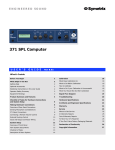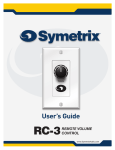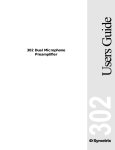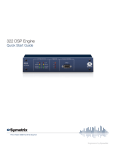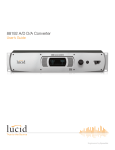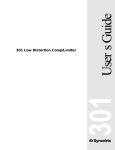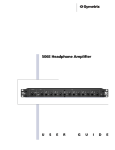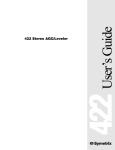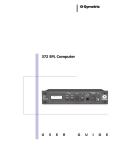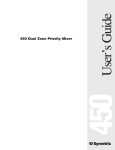Download 371 SPL Computer
Transcript
371 SPL Computer User’s Guide Safety 6408 216th Street SW | Mountlake Terrace, WA 98043 USA T +1.425.778.7728 F +1.425.778.7727 | www.SymetrixAudio.com User’s Guide 2 Safety 371 SPL Computer What Ships in the Box • A 371 hardware unit. • One PS-3 (115 VAC), or PS-3E (230 VAC) power supply. • This User’s Guide. Getting Help Voice Processor 2x, the Windows application that controls the hardware, includes a help module which acts as a complete User’s Guide for both hardware and software. If you have questions beyond the scope of this Quick Start Guide or the help module, contact our Customer Support Group in the following ways: Important Safety Instructions ! @ # $ % ^ & 8:00 am to 4:30 pm Monday through Friday, Pacific Time Read these instructions. Keep these instructions. Heed all warnings. Do not use this apparatus near water. This apparatus shall not be exposed to dripping or splashing and no objects filled with liquids, such as vases, shall be placed on the apparatus. No user serviceable parts inside. Refer servicing to qualified service personnel. Il ne se trouve a l’interieur aucune piece pourvant entre reparée l’usager. S’adresser a un reparateur compétent. G The lightning flash with arrowhead symbol within an equilateral triangle is intended to alert the user of the presence of uninsulated “dangerous voltage” within the product’s enclosure that may be of sufficient magnitude to constitute a risk of electric shock to persons. The exclamation point within an equilateral triangle is intended to alert the user of the presence of important operating and maintenance (servicing) instructions in the literature accompanying the product (i.e. this Quick Start Guide). G CAUTION: To prevent electric shock, do not use the polarized plug supplied with the unit with any extension cord, receptacle, or other outlet unless the prongs can be fully inserted. G Power Source: This Symetrix hardware uses a switching power supply that automatically adjusts to the applied voltage. Ensure that your AC mains voltage is somewhere between 100-240 VAC, 50-60 Hz. Use only the power cord and connector specified for the product and your operating locale. A protective ground connection, by way of the grounding conductor in the power cord, is essential for safe operation. The appliance inlet and coupler shall remain readily operable once the apparatus has been installed. G User Serviceable Parts: There are no user serviceable parts inside this Symetrix product. In case of failure, customers inside the U.S. should refer all servicing to the Symetrix factory. Customers outside the U.S. should refer all servicing to an authorized Symetrix distributor. Distributor contact information is available online at: http://www.SymetrixAudio.com. Do not block any ventilation openings. Install only in accordance with the manufacturer’s instructions. ( This apparatus shall be connected to a mains socket outlet with a protective earthing connection. Do not defeat the safety purpose of the polarized or grounding-type plug. A polarized plug has two blades with one wider than the other. A grounding type plug has two blades and a third grounding prong. The wide blade or the third prong are provided for your safety. If the provided plug does not fit into your outlet, consult an electrician for replacement of the obsolete outlet. This device complies with part 15 of the FCC Rules. Operation is subject to the following two conditions: (1) This device may not cause harmful interference, and (2) this device must accept any interference received, including interference that may cause undesired operation. DE CHOC ELECTRIQUE AVIS: RISQUE NE PAS OUVRIR SEE OWNERS MANUAL. VOIR CAHIER D’INSTRUCTIONS. Clean only with dry cloth. Do not install near any heat sources such as radiators, heat registers, stoves, or other apparatus (including amplifiers) that produce heat. Web:http://www.SymetrixAudio.com TO REDUCE THE RISK OF FIRE OR SHOCK DO NOT EXPOSE WARNING: ELECTRIC THIS EQUIPMENT TO RAIN OR MOISTURE Follow all instructions. * Tel: +1 (425) 778-7728 CAUTION RISK OF ELECTRIC SHOCK DO NOT OPEN This Class B Digital apparatus meets all requirements of the Canadian Interference-Causing Equipment Regulations BL Protect the power cord from being walked on or pinched particularly at plugs, convenience receptacles, and the point where they exit from the apparatus. Cet appariel numerique de la classe B respecte toutes les Exigences du Reglement sur le materiel brouilleur du Canada. BM Only use attachments/accessories specified by the manufacturer. BN Use only with the cart, stand, tripod, bracket, or table specified by the manufacturer, or sold with the apparatus. When a cart is used, use caution when moving the cart/apparatus combination to avoid injury from tip-over. BO Unplug this apparatus during lightning storms or when unused for long periods of time. BP Refer all servicing to qualified service personnel. Servicing is required when the apparatus has been damaged in any way, such as power-supply cord or plug cord is damaged, liquid has been spilled or objects have fallen into the apparatus, the apparatus has been exposed to rain or moisture, does not operate normally, or has been dropped. 3 Overview User’s Guide Introduction This simple, yet sophisticated SPL Computer is designed to ensure that foreground music and/or paging announcements are always clearly audible and distinct, but never too loud. Proprietary AmbiSense™ technology monitors ambient noise levels continuously, not just during gaps in the audio program, and responds quickly to sudden changes. Setup is simple: enter the parameters of the “normal” acoustic environment, then tell the 371 how much to change the gain, and how quickly to raise or lower it, whenever measured noise levels deviate from the parameters you have set. The front panel LCD guides you with step-through menus. Install a simple, precise and cost-effective solution: the 371 SPL Computer, backed by over 15 years of SPL processing innovation from Symetrix, the engineering-driven company of signal processing specialists. Feature Summary External Microphone connection for Continuously Monitoring Ambient Noise Levels Using an external microphone to measure changes in the ambient noise level, AmbiSense™ technology responds to environmental noise changes in realtime — not just during gaps in audio program. Headphone Monitoring Monitor the sense signal using a separate front panel headphone output. 3 Operating Modes Active: Indicates continuous measurement of the ambient noise level. History: Displays the lowest and highest SPL readings from when the unit was last reset Bypass: Bypasses the unit. Audio passes through at unity gain. Signal Path Accepts mono or stereo signals via Euroblock connectors. Easy Calibration Uses step-through menus on the front panel LCD. Calibration performed under typical installation conditions. No waiting for the quietest or noisiest ambient conditions. Ratio Adjustment Choose an adjustment ratio of SPL change vs. program level change. Sense Signal Measuring Display numeric reading and relative bargraph of the signal appearing at the sense terminals. Gain Controls Set minimum and maximum limits for SPL gain range. Gain range is –30 dB to +20 dB. Averaging Time Choose integration time of the running average SPL. Phantom Power Sense input provides 15 VDC phantom power to microphone. Enable or disable in front panel LCD menu. Ducker Control Ducker input provides momentary reduction of program level (from 0 dB to –40 dB) and inhibits sense operation for the duration of the externally supplied line level ducking control signal. Remote Control Option Connect rotary potentiometer or Symetrix RC-3 for remote control of output level. 6408 216th Street SW | Mountlake Terrace, WA 98043 USA T +1.425.778.7728 F +1.425.778.7727 | www.SymetrixAudio.com 4 Front/Rear Panel 371 SPL Computer Front Panel Item Description LCD Display Two lines show levels and settings of selected menu option. Next From normal operation, the first press enters the setup mode; subsequent presses step through the setup process and save settings. Exit Exits the setup mode and saves changes to settings. The unit reverts to normal operation. Adjust Turn to change the selected parameter. Cal Press to have the 371 read the current ambient level and equate this reading to 0 dB (unity) gain. Displays the relative ambient reading which it considers as normal. CAL is only active in normal operating mode and when setup is unlocked. Headphone 1/4 inch TRS jack suitable for headphone impedances of 60 Ohms or higher, stereo or mono. Enables listening to the output of the sensing system. Helpful for troubleshooting or for figuring out what the 371 sense mic is actually ‘hearing’. Monitor Adjusts the volume level at the headphone jack. Rear Panel Item Description 7-pin DIN Connector Connect the 7-pin DIN plug end of a Symetrix PS-3 (115 VAC) or PS-3E (230 VAC) here. Connect the AC power connector end of the PS-3 or PS-3E to an AC power source that is of the correct voltage and frequency as marked on the PS-3 or PS-3E. Remote Gain Supplies 10 VDC, a ground, and a signal input for a remote gain trim control. Use standard 10k Ohm linear potentiometer or Symetrix model RC-3. Ducker Control Balanced input for the 371. 20k Ohm balanced bridging. If connecting unbalanced sources, refer to the Input and Output Connector Wiring section. Triggers the internal ducker circuit to duck program audio and / or “freeze” the SPL computing functions. Line Output These connectors deliver a differential balanced output at 200 Ohm source impedance. If connecting unbalanced loads, refer to the Input and Output Connector Wiring section. Line Input Balanced input for the 371. 20k Ohm balanced bridging. If connecting unbalanced sources, refer to the Input and Output Connector Wiring section. Sense Input Accepts most standard dynamic and condenser microphones. Built-in mic preamp can supply 15 VDC phantom power and gain ranging from 0 dB to 70 dB in 10 dB steps. NOTE: Detachable Euroblock connectors are designed for use with bare wire. Do not tin stranded wires before inserting them into the connectors. 5 Basic Setup PS3 Power Supply CD Player REMOTE GAIN www.SymetrixAudio.com ENGINEERED AND ASSEMBLED OF U.S. AND IMPORTED MATERIALS BY SYMETRIX, INC. MOUNTLAKE TERRACE, WA USA THIS UNIT CONTAINS NO USER SERVICEABLE PARTS CONNECT TO SYMETRIX PS-3 OR PS-3E POWER SUPPLY ONLY DUCKER CONTROL LINE OUTPUT RIGHT LEFT CONÇU ET ASSEMBLÉ DES MATÉRIAUX DES ÉTATS UNIS ET IMPORTÉS PAR SYMETRIX, INC. MOUNTLAKE TERRACE, WA USA. PAS DES ELEMENTS SERVIABLE PAR UTILISATEUR 2 Connect Output to Amplifiers, EQs, Speakers, etc. Amplifier Speakers Hardware Set-up Checklist Required Optional Task to do 6 Connect page/program input source 6 Connect 371 to output device 6 Connect sense microphone 6 Connect input source for ducking 6 Connect remote volume control pot 6 Connect switch for external ducking control Connect to AC power supply 6 6 LINE INPUT RIGHT LEFT Sensing Mic SENSE INPUT Sensing Mic 2 (optional) 371 +10V POWER INPUT Connect your input devices. SPL COMPUTER 1 Connect PS-3 Power Supply to AC Power. Engineered by Symetrix in the U.S.A. 3 User’s Guide Connect headphones to hear what the 371 is sensing 6408 216th Street SW | Mountlake Terrace, WA 98043 USA T +1.425.778.7728 F +1.425.778.7727 | www.SymetrixAudio.com 6 371 SPL Computer Sensing Microphone Considerations Type of Microphone Location of Microphone For most applications, an inexpensive low-impedance, omnidirectional microphone, such as a lavalier microphone works adequately. The sensing microphone needs to “hear” the ambient sound within the controlled space. It is vital that you place the microphone where it primarily picks up a majority of noise rather than the paging or music that is going through the system. Some installers have used boundary microphones with good success (they’re unobtrusive). Do not locate the sensing microphone near a localized noise source that is not typical of the ambient noise level of the controlled zone, for example, the noise from a large machine of some sort, or maybe a kids play area, or a video game. If you do this the 371 will think that the zone is noisier than it really is. Other installers have mounted microphone cartridges (available from Mouser Electronics in the U.S.) inside electrical boxes equipped with a single-holed cover. In smaller rooms or acoustically live spaces, a directional microphone is a good choice, because you can use its position to favor the ambient sound and minimize pickup from the sound system loudspeakers. The best sense mic placement ensures that the majority of the signal picked up by the sensing microphone is ambient noise. AmbiSense allows music or page pickup without ill effects on its operation—up to about a 50:50 mix of music/ page to ambient. In an extreme case where the sense microphone picks up 100% music/ page (0% ambient noise), AmbiSense will not be able to extract enough information to use for gain control. If the sense mic is positioned a relatively long distance from the ambient noise source(s), a directional microphone may improve system performance. NOTE: No matter what kind of microphone you choose, during calibration the 371 will adapt itself to the characteristics of that mic. Disclaimer: In recognition of the relative risks and benefits to both the Integrator and SYMETRIX, INC, any recommendation or suggestion relating to the use of the Products made by SYMETRIX, INC or any other manufacturer either in technical literature or in response to a specific inquiry or otherwise, is given in good faith. HOWEVER, it is for the Integrator to satisfy himself that the products are fit for the purpose of being utilized by a Consumer as the end-user of the Products. To the fullest extent permitted by law, SYMETRIX, INC is not liable for any and all claims, losses, costs, or unforeseen damages of any nature whatsoever. It is intended that this limitation apply to any and all liability or cause of action however alleged or arising, unless otherwise prohibited by law. Capability of Sound System to Match the Maximum Required Level Calibrate at a quiet-to-average time in the controlled space. It helps if you have an estimate (sound pressure level) of the maximum desired level. Check the sound system to see that it is capable of delivering that level. 7 Connecting a Volume Controller Connect a potentiometer or another device which generates voltage between the 10 VDC output and ground of the 371. The value of the potentiometer isn’t critical; anything between 10k and 100k (linear taper) will do. For best accuracy, use the supplied 10 VDC reference at Pin 1 of the connector to drive the high side of the potentiometer. www.SymetrixAudio.com ENGINEERED AND ASSEMBLED OF U.S. AND IMPORTED MATERIALS BY SYMETRIX, INC. MOUNTLAKE TERRACE, WA USA THIS UNIT CONTAINS NO USER SERVICEABLE PARTS POWER INPUT REMOTE GAIN CONNECT TO SYMETRIX PS-3 OR PS-3E POWER SUPPLY ONLY DUCKER CONTROL +10V The 371 allows you to have remote gain control. You can connect a potentiometer or the Symetrix RC-3 Remote Control to the REMOTE GAIN Euroblock connectors. User’s Guide CONÇU ET ASSEMBLÉ DES MATÉRIAUX DES ÉTATS UNIS ET IMPORTÉS PAR SYMETRIX, INC. MOUNTLAKE TERRACE, WA USA. PAS DES ELEMENTS SERVIABLE PAR UTILISATEUR Potentiometer CCW Enable Remote Control From the LCD menu CW For the remote volume control to work, you must enable remote control. To enable remote control: ! From the LCD menu display, select the menu option Output Trim. @ Turn ADJUST fully counterclockwise (below the setting for –10) to choose Remote. The actual gain according to the remote pot setting now displays. # Press EXIT or NEXT to save setting. www.SymetrixAudio.com ENGINEERED AND ASSEMBLED OF U.S. AND IMPORTED MATERIALS BY SYMETRIX, INC. MOUNTLAKE TERRACE, WA USA THIS UNIT CONTAINS NO USER SERVICEABLE PARTS POWER INPUT REMOTE GAIN CONNECT TO SYMETRIX PS-3 OR PS-3E POWER SUPPLY ONLY +10V Keep gain in –10 dB to +10 dB range for accurate operation. However, a remote pot can “dim” the audio down to –50 dB temporarily. CONÇU ET ASSEMBLÉ DES MATÉRIAUX DES ÉTATS UNIS ET IMPORTÉS PAR SYMETRIX, INC. MOUNTLAKE TERRACE, WA USA. PAS DES ELEMENTS SERVIABLE PAR UTILISATEUR CCW Symetrix RC-3 6408 216th Street SW | Mountlake Terrace, WA 98043 USA T +1.425.778.7728 F +1.425.778.7727 | www.SymetrixAudio.com 8 CW DUCKER CONTROL External Ducking Control 371 SPL Computer The DUCKER CONTROL input is normally connected to a line level audio signal from any source you would like to use to trigger a momentary decrease in volume (ducking). Alternatively, you can choose to attach to the DUCKER CONTROL a momentary switch or relay contact to manually control ducking. Such a switch might be a push-to-talk switch contact within a microphone or a manual switch on a control panel. One isolated SPST (single pole single throw) normally open contact is required. www.SymetrixAudio.com ENGINEERED AND ASSEMBLED OF U.S. AND IMPORTED MATERIALS BY SYMETRIX, INC. MOUNTLAKE TERRACE, WA USA THIS UNIT CONTAINS NO USER SERVICEABLE PARTS POWER INPUT CONNECT TO SYMETRIX PS-3 OR PS-3E POWER SUPPLY ONLY REMOTE GAIN DUCKER CONTROL +10V NOTE: The signal applied to the DUCKER CONTROL input does not get mixed with the program audio. In other words, the ducking input signal functions only as a control signal. Paging System CONÇU ET ASSEMBLÉ DES MATÉRIAUX DES ÉTATS UNIS ET IMPORTÉS PAR SYMETRIX, INC. MOUNTLAKE TERRACE, WA USA. PAS DES ELEMENTS SERVIABLE PAR UTILISATEUR To enable ducking, you must also set parameters in the LCD menu. Set Ducking Parameters in LCD Setup Menu External switch or relay contact ! If you are using audio to control ducking set the Ducker Threshold between -30 dBu and +20 dBu. The correct setting is dependent up the average level of your incoming signal. Experiment until it sounds right to you. @ If you are using a switch to control ducking then set the Ducker Threshold somewhere between 0 and +10 dBu. # Set the Ducker Depth for the desired amount of signal attenuation when ducking is active. Ducking takes place whenever the audio ducking signal exceeds the threshold or whenever the switch contacts are closed, depending upon which ducking method you have chosen. Sensing is inhibited while ducking is in process, therefore gain remains fixed during the ducking event. NOTE: If Ducker Depth is set to zero applying a ducking signal will freeze the gain. 9 Input/Output Wiring User’s Guide Input Connections Terminal Strip [balanced] These connectors are designed for use with bare wire. Do not tin stranded wires before inserting them into the connectors. Balanced Terminal Strip For Unbalanced Connections Euroblock Connector Channel Input/Output NOTE: Detachable Euroblock connectors are designed for use with bare wire. Do not tin stranded wires before inserting them into the connectors. Connect the (–) input terminal to the source ground at the source. Feeding unbalanced inputs directly from balanced outputs is not recommended due to the possibility of ground loops. You may want to use an isolation transformer to break the ground connection and eliminate the ground loop. XLR Female Plug [balanced] Pin 2 Pin 3 Pin 1 Pin 2 = (+) Plus Pin 3 = (–) Minus Pin 1 = Ground Euroblock Connector Channel Input Output Connections These connectors deliver a differential balanced output signal (mimics a grounded center tap transformer winding). For Unbalanced Loads XLR Male Plug [balanced] With unbalanced loads, it is preferable to carry the low side of the input all the way back to the ground connection of the source. Pin 2 Pin 2 = (+) Plus Pin 3 Pin 3 = (–) Minus Pin 1 Pin 1 = Ground Use the (+) output terminal and the ground terminal. Ignore (float) the (–) output terminal. Euroblock Connector Channel Output TRS 1/4" Plug [balanced] Tip = (+) Plus Ring = (–) Minus Sleeve = Ground Euroblock Connector Channel Input/Output TS 1/4" Plug [unbalanced] Tip = (+) Plus Sleeve = Ground ! IMPORTANT NOTICE 1 ! 1 Euroblock Connector Channel Input The wiring diagrams on this page are included for information purposes only. Symetrix can not anticipate exactly what connection is needed at the non-371 end of the cable. It is the user’s responsibilty to determine what connection is needed. TS 1/4" Plug [unbalanced] Tip = (+) Plus Sleeve = Ground In addition, Symetrix accepts no responsibilty for injury or damage caused by user created wiring. 6408 216th Street SW | Mountlake Terrace, WA 98043 USA T +1.425.778.7728 F +1.425.778.7727 | www.SymetrixAudio.com 10 Euroblock Connector Channel Output System Setup 371 SPL Computer System Set-up Checklist Required Recommended Optional Task to do Choose Operating Mode 6 6 View calibration Status 6 Collect History of highest and lowest SPLs View Sense levels 6 6 Enable Phantom Power 6 Set Sense Input Gain Specify Output Trim 6 Set MIN Limit 6 Specify Averaging Time 6 Specify Gain: Sense Ratio 6 6 Set Ducker Depth 6 Set Ducker Threshold Lock or Unlock Setup 6 General Operation of the 371’s LCD Menu Screen Use the two push buttons, NEXT and EXIT, along with the parameter adjustment knob, ADJUST, to gain access to menu setup options in the LCD display. !Press NEXT to enter the setup mode. @ Turn ADJUST to select a specific value or choice. # Press NEXT again to gain access to another menu option. Subsequent presses of NEXT change menu options and save settings. $ Press NEXT or EXIT to end the setup process, save any changes made, and return the unit to normal operation. —or— Allow 20 minutes of inactivity, after which the unit automatically returns to normal operation. After setup is complete, calibrate the unit (See the Calibration section). 11 System Setup User’s Guide Press NEXT to advance through the different Menu selections Status Startup Screen Cal: Startup Screen displays current gain applied by the unit. When the 371 senses a signal at the DUCKER INPUT, Duck displays. Ambient signal level measured at the last sense period. Min: Operating mode Max: Turning the ADJUST knob lets you select one of these three operational modes Maximum gain that the 371 is permitted to have. Active Displays numeric readings of the highest and lowest SPLs from whenever the 371 unit was calibrated or from when the setting was last reset. Displays the current calibration status of the 371. Minimum gain that the 371 is permitted to have. History: Reset to Zero Select this mode if you want the 371 to vary the gain of this program channel to match the ambient noise level. Resetting the 371 to Zero starts a new history period, where the 371 begins to collect the highest and lowest relative SPL readings. How Sampling Works—The 371 takes SPL measurements every 10 ms through the sensing microphone. History Sense Select this mode if you only want the 371 to collect data about the highest and lowest ambient SPL in the installation zone(s). Displays bargraph of current ambient noise level. Phantom Power The 371 does not perform any gain control in this mode. You can determine the start of the history period or collection of data. See in this section History to reset or start the collection of the relative SPL history. ON +15 V, OFF To turn on or off 15 V phantom power for the sense microphone. Enable only if your microphone requires it. Ducking can be made active in this mode if desired. Sense Input Gain Bypass 0, 10, 20, 30, 40, 50, 60, 70 dB Select this mode when you want to leave the 371 physically connected in the signal path, only pass the signal unaltered, and never take SPL samples. Select the amount of gain that is required for the sense microphone. For proper calibration, the internal preamp must produce a signal in the range of –45 dB to 20 dB. Refer to Sense (above) for relative SPL readings. This feature is useful if you encounter setup problems in an installation. You can temporarily disable the 371 until you have the time to correct the problem. Or when the action of the 371 is temporarily unwanted, for example, when an unusual event is taking place. Output Trim –10 dB to +10 dB in 1 dB increments You can view your control settings in this mode. Any changes you make to your control settings in this mode, will not take effect. To add to or subtract from the overall output gain from the front panel or via remote (control the output trim with a potentiometer or with the RC-3 Remote Control). Keep gain in –10 dB to +10 dB range for accurate operation. However, a remote pot can “dim” the audio down to –50 dB temporarily. The gain is always held at unity (0 dB) in this mode. Bypass mode is not a hard-wire bypass. 6408 216th Street SW | Mountlake Terrace, WA 98043 USA T +1.425.778.7728 F +1.425.778.7727 | www.SymetrixAudio.com 12 System Setup 371 SPL Computer Set MIN Limit Ducker Depth –30 dB up to the actual setting of the maximum limint in 1 dB increments 0 dB to –40 dB To set the ducking range. Upon ducking, the program outputs drop according to the value selected. External DUCKER CONTROL signal does not mix with internal program signal. The external control signal merely initiates ducking action. To adjust the lowest gain setting that the 371 uses. This ensures a known minimum level from the sound system, even if the ambient drops to dead silence. Averaging Time Ducker Threshold 1, 3, 10, 30 seconds – 1.5, 5, 15 minutes +20 dB to –30 dB To adjust the reaction time at which the 371 adjusts to the ambient level. Longer running averages make the system respond more to the trend of the ambient level rather than the most recent events. To set the minimum signal level needed for the 371 to acknowledge ducking input. The 371 program outputs drop to the Ducker Depth if the DUCKER CONTROL input rises above the Ducker Threshold. Gain:Sense Ratio Setup Unlocked 0.5:1, 1:1, 1.5:1, 2:1 NOTE - The displayed ratio values are guide lines only and not absolute values. The AmbiSense algorithm may modify these ratios based upon the data it gathers during the calibration process. Unlocked, Locked Choose to protect front panel LCD menu settings from being altered. To lock, press and hold CAL while turning ADJUST. Once it’s locked, pressing NEXT shows the current settings. Any attempt to alter settings results in the display of the message “Setup is Locked”. To unlock, press NEXT until the display reads Setup is Locked. Press and hold CAL while turning ADJUST. The front panel is now unlocked. Refers to the change in gain of the 371 versus the change in the ambient. 0.5:1 changes gain 0.5 dB for every 1 dB change in the ambient. This makes the sound system louder in response to increases in the ambient, but never tries to “out-shout the crowd”. 1:1 matches gain changes to the ambient noise level. 1.5:1 changes gain 1.5 dB for every 1 dB increase in the ambient noise level. 2:1 changes gain 2 dB for every 1 dB increase in the ambient noise level. NOTES: • At a 2:1 ratio with high ambient levels, the 371 can easily “out shout” the crowd. • At lower ambient levels, the 371 might let the sound system get lost in the ambient. To avoid this, choose a higher (closer to 0 dB) minimum gain and/or a higher ratio. 13 Calibration User’s Guide What Does Calibration Do? $When the LCD menu displays Adjust to Maximum, turn The calibration process correlates the current ambient noise level to 0 dB (unity) gain. As the ambient SPL becomes less, the 371 lowers its gain. Conversely, when the SPL increases, the gain of the 371 increases. %Next, the LCD menu displays whether calibration ADJUST to set the maximum gain for the program output. The gain range is 0 dB to +20 dB in 1 dB steps. succeeded or not. Proper calibration is vital to the proper operation of the 371. The AmbiSense algorithm will not function correctly if the calibration procedures are not executed. ^When calibration is finished, the 371 displays the relative What To Do Before Calibration Calibration can fail if the Sense Input Gain is set too low (–45 dB) or too high (+20 dB). In the LCD setup menus, adjust Sense Input Gain for a proper gain setting. ambient SPL reading which it considers as normal. What to Do If Calibration is Unsuccessful Before calibration, setup the SENSE INPUT. System setup menu items that control the Sense Input are Phantom Power and Sense Input Gain. Check Sense for the current sense input level. The setting should be between –45 dB and +20 dB. THIS IS IMPORTANT! • Calibrate when the ambient noise in the area being controlled is at a level typical of normal conditions. You can also check the SENSE INPUT by listening with headphones connected to AMBIENT SENSE MONITOR on the front panel to hear what the 371 is reading. • Use the highest paging or music input levels that you are likely to encounter during normal operation. What You Should Not Do After Calibration Do not adjust the level of any volume controls in the sound system signal path after the 371. Doing so will cause the AmbiSense technology to yield erroneous results. Controls that must remain fixed include amplifier input level controls, wall-mounted L-Pad style speaker attenuators, etc. Adjust Sense Input Gain until Sense displays a bargraph showing a mid-level sense signal. Make sure you leave enough headroom so that increased ambient levels do not overdrive the sense input. For example, if you expect that ambient noise levels will rise 20 dB above the currently observed levels, adjust the Sense Input Gain to leave more than 20 dB of headroom under current conditions. Also, do not insert compressors or limiters into the signal path after the 371. If you need to adjust amplifier input levels, re calibrate the 371 afterward to reset the data collected by the AmbiSense algorithm. If you need to trim the overall system level up or down after calibration, you can do this by adjusting the Output Trim. Only perform calibration when the setup for the 371 is unlocked (See System Setup>Description of Menu Options>Setup Unlocked). Pressing CAL when the setup is locked will do nothing. How to Calibrate !On the front panel, press CAL. The 371 sets software controlled gain to 0 dBu (unity). The LCD menu displays Unity Gain … Cal to proceed. @Adjust the other components in the sound system (music level, power amp gain, etc.) for the desired program level during average conditions. #If you wish to continue with calibration then press CAL again. If you do not wish to continue with calibration then press EXIT and the calibration process will abort. The 371 reads the ambient level on the SENSE INPUT. This level will be the unity reference (0 dB) for the 371. 6408 216th Street SW | Mountlake Terrace, WA 98043 USA T +1.425.778.7728 F +1.425.778.7727 | www.SymetrixAudio.com 14 Block Diagram 371 SPL Computer LINE INPUT LEFT LINE INPUT RIGHT DUCKER CONTROL REMOTE GAIN BAL INPUT VCA RMS DETECT BAL INPUT BAL INPUT AVERAGE LEVEL DETECT ADJUST SPL CPU DC AMP MIC/LINE INPUT LINE OUTPUT RIGHT VCA CALIBRATE MENU EXIT AVERAGE LEVEL DETECT MENU NEXT RMS DETECT PHANTOM POWER SENSE INPUT LINE OUTPUT LEFT SENSE GAIN BANDPASS FILTER 15 SENSE MONITOR VOLUME SENSE HEADPHONE Troubleshooting User’s Guide No output signal Unit does not control levels as expected Check to see that the LCD display is illuminated and the unit is plugged in. Using headphones connected to the front panel headphone jack, listen to the sense signal to verify that the SENSE INPUT is receiving a signal that accurately represents ambient noise conditions. Listen for hums, buzzes, or interference that might be masking true ambient noise. Move sense mic if necessary. Adjust Sense Input Gain to proper level. Check cables and connections to see if: • Outputs are driving inputs and inputs are fed from outputs. • Signal is coming from the source(s) and that it is getting to the 371. Unit will not calibrate Also, it may be possible that someone accidentally changed downstream level controls after the unit was last calibrated. This change causes AmbiSense to produce erroneous results. Correct this by recalibrating the unit. Check that input levels are normal. NOTES: Use headphones to hear what the 371 reads. Check Sense Input Gain to to see if the setting is between –45 dB and +20 dB. Calibration will fail if it is below or above these levels. • The accuracy of the 371 is only as good as the quality of your microphones. • The signal chain after the 371 is functioning. • The actual gain-sense ratio may differ from the setting chosen during set up and diplayed on the LCD. The displayed ratios are guidelines only. The AmbiSense algorithm may modify the actual ratios based upon the data it gathers during the calibration process as necessary. Check sensing microphone connections. Enable Phantom Power if you are using a microphone that requires it. Music always plays too loud Check levels in Set MIN Limit. Unit is at minimum gain all the time Check if the level is set too high in the Gain: Sense Ratio. Check if microphone is connected or turned on. Check in calibration if the maximum limit in Adjust to Maximum is set too high. Check signal at sense input. Ducker doesn’t work Unit seems to have no effect Ducker Threshold set too high. Check the ratio setting for Gain: Sense Ratio. At 0.5:1, the gain changes are very subtle. Choose a larger value for more change. Ducker Depth set to 0. Check connections to see if input signal is connected and turned on. Check the bargraph in Sense to see if the sense level is always the same, because then the gain will always be the same. Noise (hiss) Check input signal levels and level control settings. Check to see if it’s in HISTORY or BYPASS mode. Check gain settings on downstream equipment for presence of noise in input signal. 6408 216th Street SW | Mountlake Terrace, WA 98043 USA T +1.425.778.7728 F +1.425.778.7727 | www.SymetrixAudio.com 16 Troubleshooting 371 SPL Computer Hum or buzz in output Check input connector wiring. Check for a ground loop problem. Inspect related system equipment grounding to see that all system components are on the same AC ground. Distortion Check input signals for distortion. Check if line input signal is too hot. Check if the sound system has sufficient power for the SPL that you are trying to attain. If using a high setting for Adjust to Maximum in calibration, you may be overloading the input to your amplifier; select a lower value. Ensure that something downstream isn’t clipping. No audio using remote volume controls Check Output Trim to see if Remote is enabled. 371 is inoperative Certain uncontrollable events (lightning, flood, nuclear blast, other catastrophic disturbances) can corrupt the 371’s memory rendering it inoperable. To return the 371’s memory to its factory default state: !Disconnect AC power. @Press and hold in the NEXT and EXIT buttons. #Re-connect AC power. $Release the NEXT and EXIT buttons. %Press and release EXIT three times. Now the LCD screen will display “EEPROM defaults restored” followed by the software version number. After doing this, all previous setup and calibration data will have been lost and must be re-entered as if it were a brand new installation. ^Give to you favorite charity generously. Music/page is too loud Try re-calibrating making sure that music/page is playing continuously during the calibration process at it’s normal or normal to high level. 17 Specs • Declaration of Conformity User’s Guide Architects and Engineers Specifications Specifications... continued The Ambient Level Controller (ALC) shall control the output level of the sound system in response to the observed acoustical noise level within the controlled space during system operation. These measurements shall be made continuously, not just during gaps in the audio program. The ALC shall utilize microphones to sense the ambient noise level. The unit shall incorporate front-panel headphone output enabling the user to monitor the ambient sense signal system. The ALC shall provide user-adjustable parameters to alter the way that it responds to changes in the ambient noise level. These parameters are: minimum and maximum gain through the device, noise sensing protocol, gain:sense ratio, ducker control, output trim, and averaging time. In addition, the ALC shall provide an active signal mode, bypass mode, and a history mode that collects and displays ambient noise history from the controlled space. The ALC shall provide two independent line level balanced inputs and outputs that control two audio signals. The maximum input level shall be +20 dBu and the maximum output level shall be +26 dBu (+22 dBm into 600 Ohms) balanced. The balanced input impedance shall be 20,000 Ohms and the output source impedance shall be 200 Ohms balanced, 100 Ohms unbalanced. The gain control range shall be –30 dB to +20 dB. The frequency response shall be 20 Hz to 20 kHz +0/–1 dB with THD+N less than 0.25% at +4 dBu over the same range of frequencies. The output noise of the device shall be less than –95 dBu (20 kHz noise bandwidth, unity gain). The input and output configuration shall be active balanced. In addition to the audio input/output connections, there shall be connections provided for a sense input and remote trim control. A front panel power indicator shall be provided. A liquid crystal display shall be provided to communicate operating parameters and setup information with the user. The ALC shall occupy half of the width of one rack space and shall be housed in a metal enclosure. It shall use an external, safety agency approved, power supply. The Ambient Level Controller shall be the Symetrix model 371 SPL Computer. Electrical Power Requirements 115 VAC nominal, 95 to 130 VAC, 50 to 60 Hz 230 VAC nominal, 207 to 253 VAC, 50 Hz 10 watts maximum, PS-3 or PS-3E only Declaration of Conformity We, Symetrix Incorporated, 6408 216th St. SW, Mountlake Terrace, Washington, USA, declare under our sole responsibility that the product: 371 SPL Computer to which this declaration relates, is in conformity with the following standards: EN 60950 Safety requirements for mains operated electronic and related apparatus for household and similar general use. EN 55103-1 Product family standard for audio, video, audio-visual and entertainment lighting control apparatus for professional use. Part 1: Emission EN 55103-2 Generic immunity standard. Part 1: Residential, commercial, and light industry. The technical construction file is maintained at: Symetrix, Inc. 6408 216th St. SW Mountlake Terrace, WA, 98043 USA The authorized representative located within the European Community is: World Marketing Associates P.O. Box 100 St. Austell, Cornwall, PL26 6YU, U.K. Specifications Input/Output Maximum Input Level +20 dBu balanced Program Input Impedance > 20k Ohms balanced, > 10k Ohms unbalanced Input Common Mode Rejection Ratio > 40 dB, line inputs Maximum Output Level +26 dBu balanced, 20k Ohm load, +22 dBm balanced, 600 Ohm load Output Impedance 200 Ohms balanced, 100 Ohms unbalanced Date of issue: January 1, 2001 Place of issue: Lynnwood, Washington, USA Authorized signature: Performance Data Program Frequency Response 20 Hz to 20 kHz, +0, -1 dB Program Path THD+Noise < 0.025% (+4 dBu in, +4 dBu out) Output Gain Range +20, -30 dB Sense Channel Frequency Response -3 dB at 300 Hz and 6000 Hz, 3-pole Butterworth Sense Channel Gain selectable, 0 dB to +70 dB Headphone Monitor Gain 28 dB maximum Program Channel Output Noise -95 dBu @ unity gain, typical Output Trim Range +/- 10 dB Dane Butcher, President, Symetrix Incorporated. Connections All Inputs, Outputs and Control Ports Power In Euroblock 7-pin DIN Physical Size (hwd) ½ rack unit 1.75 x 8.5 x 6.5 in., 4.445 x 21.59 x 15.875 cm. Shipping Weight 4.5 lbs / 2.03 kg Environmental Maximum Ambient Operating Temperature 40˚ C (104˚ F) 6408 216th Street SW | Mountlake Terrace, WA 98043 USA T +1.425.778.7728 F +1.425.778.7727 | www.SymetrixAudio.com 18 Warranty and Service 371 SPL Computer The Symetrix Limited Warranty Servicing Your Symetrix Product Symetrix, Inc. expressly warrants that the product will be free from defects in material and workmanship for eighteen (18) months from the date the product is shipped from the factory. Symetrix’s obligations under this warranty will be limited to repairing or replacing, at Symetrix’s option, the part or parts of the product which prove defective in material or workmanship within eighteen (18) months from the date the product is shipped from the factory, provided that the Buyer gives Symetrix prompt notice of any defect or failure and satisfactory proof thereof. Products may be returned by Buyer only after a Return Authorization number (RA) has been obtained from Symetrix. Buyer will prepay all freight charges to return the product to the Symetrix factory. Symetrix reserves the right to inspect any products which may be the subject of any warranty claim before repair or replacement is carried out. Symetrix may, at its option, require proof of the original date of purchase (dated copy of original retail dealer’s invoice). Final determination of warranty coverage lies solely with Symetrix. Products repaired under warranty will be returned freight prepaid via United Parcel Service by Symetrix, to any location within the Continental United States. Outside the Continental United States, products will be returned freight collect. If you have determined that your Symetrix product requires repair services and you live outside of the United States please contact your local Symetrix dealer or distributor for instructions on how to obtain service. If you reside in the U.S. then proceed as follows: Return Authorization At the Symetrix factory, Symetrix will perform in-warranty or out-ofwarranty service on any product it has manufactured for a period of three (3) years from date of discontinued manufacture. Before sending anything to Symetrix, please contact our Customer Service Department for a Return Authorization (RA) number. The telephone number is +1 (425) 778-7728. Additionally, support is available via the web site: http://support.SymetrixAudio.com. In-warranty Repairs To get your Symetrix product repaired under the terms of the warranty: The foregoing warranties are in lieu of all other warranties, whether oral, written, express, implied or statutory. Symetrix, Inc. expressly disclaims any IMPLIED warranties, including fitness for a particular purpose or merchantability. Symetrix’s warranty obligation and buyer’s remedies hereunder are SOLELY and exclusively as stated herein. This Symetrix product is designed and manufactured for use in professional and studio audio systems and is not intended for other usage. With respect to products purchased by consumers for personal, family, or household use, Symetrix expressly disclaims all implied warranties, including but not limited to warranties of merchantability and fitness for a particular purpose. 1. Call us for an RA number (have the serial number, shipping and contact information and description of the problem ready). 2. Pack the unit in its original packaging materials. 3. Include your name, address, daytime telephone number, and a brief statement of the problem. 4. Write the RA number on the outside of the box. 5. Ship the unit to Symetrix, freight prepaid. We do not accept freight collect shipments. Just do these five things, and repairs made in-warranty will cost you only one way freight charges. We’ll pay the return freight. Symetrix does not authorize any third party, including any dealer or sales representative, to assume any liability or make any additional warranties or representation regarding this product information on behalf of Symetrix. If you don’t have the factory packaging materials, we recommend using an oversize box. Wrap the unit in a plastic bag, surround it with bubblewrap, and place it in the box surrounded by Styrofoam peanuts. Be sure there is enough clearance in the box to protect the rack ears. We won’t return the unit in anything but Symetrix packaging for which we will have to charge you. If the problem is due to operator misuse or error, you will have to pay for both parts and labor. In any event, if there are charges for the repair, you will pay for the return freight. All charges will be COD unless you have made other arrangements (prepaid, Visa or Mastercard). This limited warranty gives the buyer certain rights. You may have additional rights provided by applicable law. Out-of-warranty Repairs Note: Some Symetrix products contain embedded software and may also be accompanied by control software intended to be run on a personal computer. Said software is specifically excluded from this warranty. If the warranty period has passed, you’ll be billed for all necessary parts, labor, packaging materials, and freight charges. Please remember, you must call for an RA number before sending the unit to Symetrix. This limited warranty, with all terms, conditions and disclaimers set forth herein, shall extend to the original purchaser and anyone who purchases the product within the specified warranty period. Limitation of Liability The total liability of Symetrix on any claim, whether in contract, tort (including negligence) or otherwise arising out of, connected with, or resulting from the manufacture, sale, delivery, resale, repair, replacement or use of any product will not exceed the price allocatable to the product or any part thereof which gives rise to the claim. In no event will Symetrix be liable for any incidental or consequential damages including but not limited to damage for loss of revenue, cost of capital, claims of customers for service interruptions or failure to supply, and costs and expenses incurred in connection with labor, overhead, transportation, installation or removal of products, substitute facilities or supply houses. 19 Item No. 53-0005 371 SPL Computer User’s Guide © 2009 Symetrix, Inc. All rights reserved. Printed in the United States of America. The information in this document is subject to change without notice. Symetrix, Inc. shall not be liable for technical or editorial errors or omissions contained herein; nor is it liable for incidental or consequential damages resulting from the furnishing, performance, or use of this material. Mention of third-party products is for informational purposes only and constitutes neither an endorsement nor a recommendation. Symetrix assumes no responsibility with regard to the performance or use of these products. Under copyright laws, no part of this brochure may be reproduced or transmitted in any form or by any means, electronic or mechanical, without permission in writing from Symetrix, Inc. If, however, your only means of access is electronic, permission to print one copy is hereby granted. The following are either Trademarks or Registered Trademarks of Symetrix, Inc.: Symetrix, SymNet, SymNet Designer, SymLink and CobraLink. Windows is a Registered Trademark of Microsoft, Inc.. Other product names mentioned herein may be trademarks and/or registered trademarks of other companies and are property of their respective owners. 6408 216th Street SW | Mountlake Terrace, WA 98043 USA T +1.425.778.7728 F +1.425.778.7727 | www.SymetrixAudio.com






















